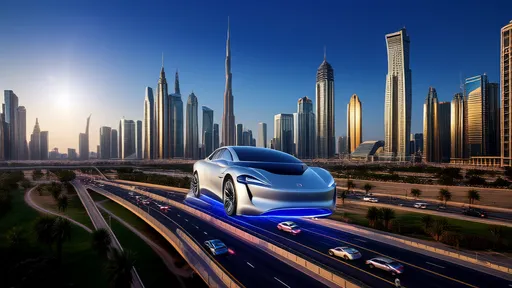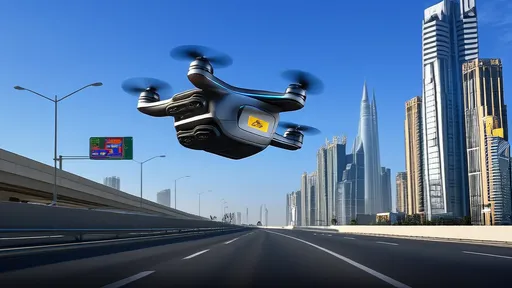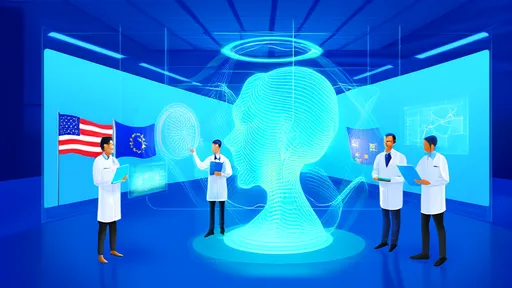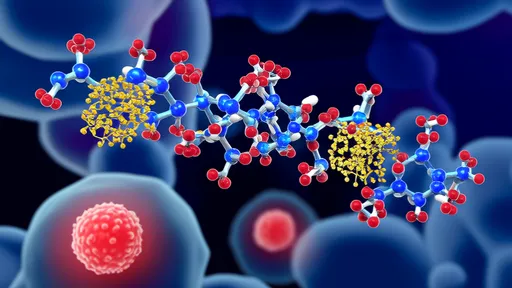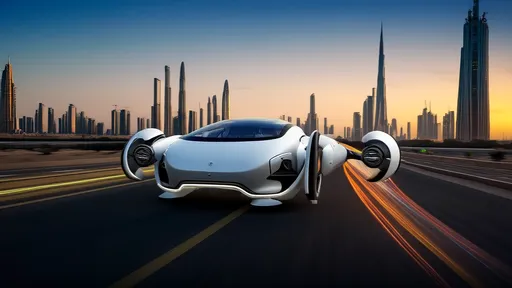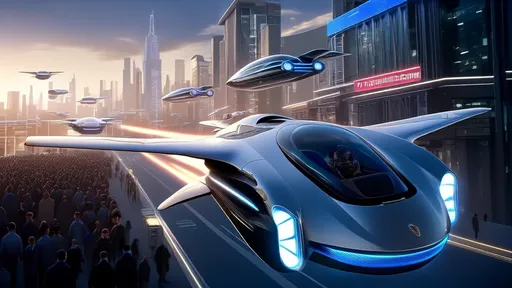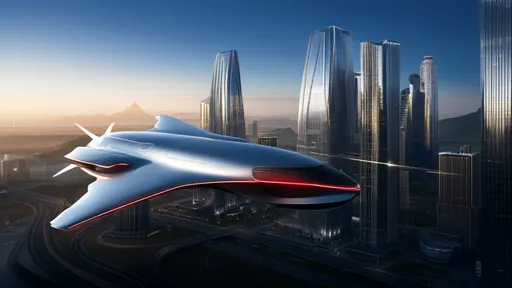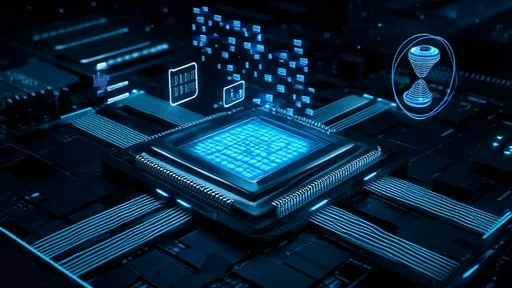The relentless march of artificial intelligence demands computational power on a scale previously unimaginable. At the heart of this revolution lies the Graphics Processing Unit, or GPU, which has evolved from a specialized graphics rendering component into the primary engine for AI workloads. The latest generation of GPU architectures represents a paradigm shift, not merely an incremental improvement. These new designs are fundamentally re-engineering the silicon to tackle the unique and colossal demands of modern AI, with a core focus on achieving unprecedented levels of computational density and efficiency through hyper-scale integration.
For years, the trajectory of computing power was largely guided by Moore's Law, the observation that the number of transistors on a microchip doubles approximately every two years. However, as transistor sizes approach physical atomic limits, simply packing more transistors onto a flat plane of silicon has become exponentially more difficult and costly. The new wave of GPU architectures confronts this challenge head-on by moving into the third dimension and embracing advanced packaging technologies. This is not just about making transistors smaller; it is about assembling them in smarter, more interconnected ways. Technologies such as Chiplet design, 2.5D, and 3D integration are moving from the fringes to the forefront, allowing for the creation of monolithic-scale compute systems that are, in reality, composed of multiple smaller, specialized "chiplets" fused together.
Chiplet architecture is a cornerstone of this new approach. Instead of designing a single, enormous, and prohibitively expensive piece of silicon, manufacturers are creating smaller, modular dies that can be mixed and matched. One chiplet might be optimized for raw floating-point performance, another for high-bandwidth memory interfaces, and another for high-speed I/O. These chiplets are then integrated onto a sophisticated interposer—a silicon or organic substrate that acts as a super-highway for data traffic between them. The result is a system that can achieve a level of performance and transistor count that would be infeasible with a traditional monolithic die, all while improving yield and potentially lowering costs.
This hyper-scale integration directly translates to a dramatic surge in AI compute efficiency. AI models, particularly the vast transformer-based models dominating fields like natural language processing, are characterized by their immense parameter counts and the parallel nature of their computations. They require two things above all: massive computational throughput and lightning-fast access to enormous datasets. The new GPU architectures are engineered specifically for this workload. By integrating specialized tensor cores, AI accelerators, and vast pools of high-bandwidth memory (HBM) in close proximity, these GPUs minimize the distance data must travel. This reduction in data movement is critical, as the energy cost of shuttling data across a chip can far exceed the cost of the computation itself.
The memory subsystem is a critical battleground in the quest for AI supremacy. Advanced packaging techniques like 3D stacking allow for HBM cubes to be placed directly on top of or right beside the compute die, connected by thousands of microscopic wires. This creates an incredibly wide data pipe, delivering terabytes per second of memory bandwidth. For an AI algorithm training on billions of data points, this means the processors are kept constantly fed with data, avoiding costly stalls and idle cycles. The compute units themselves are also becoming more specialized. Beyond general-purpose CUDA cores, we are seeing a proliferation of cores dedicated to matrix multiplication and convolution—the fundamental mathematical operations at the core of neural network training and inference.
Furthermore, this architectural evolution enables a more holistic and power-efficient system. With different functional units integrated at such a dense scale, the entire processor can operate more cohesively. Power delivery and thermal management, two of the most significant constraints in high-performance computing, are also being rethought. By distributing power across multiple chiplets and employing more efficient transistor designs, these new GPUs can deliver more performance per watt than ever before. This is not just an academic exercise; it has profound implications for the operational costs and environmental impact of massive AI data centers, where electricity consumption is a primary concern.
The software ecosystem is evolving in lockstep with the hardware. To fully harness the potential of these complex, heterogeneously integrated processors, software frameworks and compilers must become more intelligent. They need to understand the topology of the chip—the location of different memory pools, the specialized capabilities of different compute units, and the ultra-fast interconnects between chiplets. The leading companies in this space are investing heavily in their software stacks to ensure that AI developers can easily deploy their models and have the underlying system automatically map computations to the most efficient pathways available within the architecture.
In practical terms, the impact of these new GPU architectures is already being felt across the industry. They are slashing the time required to train large language models from weeks to days, or even hours. This acceleration of the research and development cycle is enabling faster iteration and the exploration of more complex AI paradigms. In the inference phase, where trained models are deployed to make real-world predictions, these architectures deliver the low-latency, high-throughput performance necessary for applications from real-time language translation and autonomous vehicle navigation to complex scientific simulation and drug discovery.
Looking ahead, the path is clear: the future of AI computation lies in specialization and integration. The era of the general-purpose processor acting as the sole workhorse for AI is fading. The next generation of GPUs will likely feature even greater levels of integration, potentially incorporating optical interconnects to eliminate data bottlenecks further and maybe even integrating silicon photonics directly onto the package. We are also seeing the emergence of domain-specific architectures that are custom-built for particular AI workloads, yet they all rely on the same fundamental principles of hyper-scale integration to achieve their goals.
In conclusion, the latest GPU architectures represent a fundamental breakthrough, moving beyond the limitations of planar scaling by embracing a multi-dimensional approach to chip design. Through the strategic use of chiplets, 3D integration, and advanced packaging, these processors achieve a level of scale and integration that unlocks new frontiers in AI computational efficiency. This is not just a step forward; it is a leap that will power the next decade of artificial intelligence innovation, enabling models and applications that are today merely speculative concepts. The engine for the future of AI is being built today, transistor by transistor, interconnect by interconnect, in three dimensions.
The once-fantastical vision of humanoid robots, long confined to the pages of science fiction and the silver screen, is steadily materializing into a tangible engineering reality. This evolution is not the result of a single, monumental breakthrough but rather a profound and intricate symphony of advancements across a multitude of scientific and engineering disciplines. The quest to create machines that not only look but also move, perceive, and interact with the fluidity and adaptability of humans represents one of the most ambitious technological endeavors of our time. It is a grand convergence, where progress in artificial intelligence, materials science, mechanical engineering, and cognitive science coalesces to breathe life into metal and silicon, pushing the boundaries of biomimicry to unprecedented heights.
The recent inclusion of humanoid robots in the 2025 Top Ten Global Engineering Achievements marks a watershed moment in technological history. This recognition transcends mere academic acknowledgment; it represents a collective global validation of decades of research, development, and iterative innovation in robotics. For years, humanoid robots existed primarily in the realms of science fiction and laboratory prototypes, often viewed as fascinating but distant curiosities. Their elevation to a top global engineering feat signals a profound shift—a transition from conceptual marvels to tangible agents of change poised to reshape our societal and industrial landscapes.
In a landmark recognition of human engineering prowess, China's full-ocean-depth manned submersible has been selected among the 2025 Top Ten Global Engineering Achievements, standing shoulder-to-shoulder with revolutionary projects like quantum computing infrastructure and Mars colonization prototypes. This prestigious listing, announced by the International Engineering Consortium earlier this morning, represents more than just technological acknowledgment—it signifies humanity's renewed commitment to conquering Earth's final frontier.
In the heart of Dubai's morning rush hour, the familiar gridlock of Sheikh Zayed Road stretches for kilometers below, but above the shimmering asphalt, a new dimension of transportation is quietly rewriting the rules of urban mobility. As first reported by The Times of India, the city's ambitious flying car initiative has transitioned from futuristic concept to operational reality, with commuters now gliding between skyscrapers in electric vertical take-off and landing vehicles. This isn't a scene from a science fiction film but the new daily reality for a growing number of Dubai residents who have traded their terrestrial commutes for the freedom of three-dimensional travel.
The desert skies of the United Arab Emirates, long dominated by the sleek silhouettes of commercial airliners and private jets, are poised to welcome a new kind of vessel. In a landmark decision that signals a significant leap from science fiction to tangible reality, a specific model of flying car has been granted a special certificate of flight from the UAE's civil aviation authority. This is not merely a provisional test permit for a closed course; it is a crucial regulatory nod that brings the vision of urban air mobility one giant step closer to the daily lives of the region's residents.
In a move signaling a new era of technological collaboration, Southeast Asian nations and the United States are forging a groundbreaking partnership in artificial intelligence development. This strategic alliance emerges at a critical juncture when global AI governance remains fragmented and the technology's potential to reshape economies and societies becomes increasingly apparent. The collaboration represents more than just technical cooperation—it embodies a shared vision for responsible innovation that respects cultural diversity while addressing common challenges.
The Euclid Space Telescope, humanity's newest and most ambitious eye on the cosmos, has begun its monumental mission to pierce the profound darkness that envelops our universe. Launched into the silence beyond our atmosphere, its purpose is not merely to capture stunning celestial portraits but to map the invisible architecture of reality itself. For decades, astronomers have known that the cosmos we see—the glittering tapestry of stars, galaxies, and nebulae—comprises a mere five percent of the total content of the universe. The remaining ninety-five percent is a profound mystery, a dual enigma composed of dark matter and dark energy. These are the phantoms of physics, entities that do not emit, absorb, or reflect light, yet whose gravitational influence dictates the fate of everything we hold visible. Euclid is our most sophisticated attempt to date to bring these shadows into the light, to understand the hidden forces that have shaped the universe's past and will determine its ultimate destiny.
Beijing's National Stadium, once the iconic centerpiece of the 2008 Summer Olympics, echoed with a different kind of applause this week. The thunderous cheers were not for human athletes pushing the limits of physical endurance, but for their mechanical counterparts—humanoid robots competing in the inaugural World Humanoid Robot Sports Games. The air, thick with the whirring of servos and the collective anticipation of engineers and spectators, marked a pivotal moment in the history of robotics and international sport.
The landscape of oncology treatment is undergoing a profound transformation, driven by the emergence of third-generation antibody-drug conjugates (ADCs). These sophisticated therapeutic agents represent a significant leap forward in the quest for precision medicine, offering new hope for patients battling various forms of cancer. Unlike conventional chemotherapy that attacks both healthy and cancerous cells indiscriminately, these advanced biologics deliver potent cytotoxic agents directly to tumor cells, minimizing damage to healthy tissues and reducing debilitating side effects.
In the relentless battle against cancer, a revolutionary class of therapeutics has emerged, earning the evocative moniker of "precision missiles" for their ability to deliver potent cytotoxic agents directly to malignant cells while sparing healthy tissue. These are Antibody-Drug Conjugates, or ADCs, and they represent a sophisticated fusion of biologic targeting and potent chemotherapy, a paradigm shift in oncology that is redefining treatment expectations for a growing number of cancers.
The desert skies above Dubai witnessed a historic moment last week as the sleek silhouette of a flying car cut through the cerulean blue, marking what many industry experts are calling the dawn of a new era in personal transportation. The demonstration, orchestrated by the pioneering aviation firm AeroMobil Emirates, was not merely a test flight; it was a powerful statement of intent, a tangible promise of a future once confined to the pages of science fiction.
In a remarkable demonstration of growing consumer confidence in aerial mobility solutions, global pre-orders for flying cars have surged past the 7,000-unit milestone. This significant threshold, reached far earlier than most industry analysts had projected, signals a fundamental shift in public perception about the viability of personal air transportation. What was once confined to science fiction novels and futuristic concept videos is rapidly transforming into a tangible consumer product category with demonstrated market demand.
In the shimmering heat of the Arabian Gulf, a new silhouette is beginning to pierce the horizon. It is not the familiar form of a commercial airliner nor the sleek profile of a private jet, but something altogether more futuristic—a flying car. This vision, once confined to the realms of science fiction, is fast becoming a tangible reality, and it is Chinese innovation that is poised to turn the skies above Dubai, Abu Dhabi, and Riyadh into a dazzling new theater of urban mobility.
The relentless march of artificial intelligence demands computational power on a scale previously unimaginable. At the heart of this revolution lies the Graphics Processing Unit, or GPU, which has evolved from a specialized graphics rendering component into the primary engine for AI workloads. The latest generation of GPU architectures represents a paradigm shift, not merely an incremental improvement. These new designs are fundamentally re-engineering the silicon to tackle the unique and colossal demands of modern AI, with a core focus on achieving unprecedented levels of computational density and efficiency through hyper-scale integration.
The ASEAN-US AI Cooperation Forum concluded its third annual session this week with a renewed commitment to bridging the digital divide through focused capacity building and infrastructure development. Held against the backdrop of rapid technological advancement, the forum brought together policymakers, industry leaders, and academics to chart a collaborative path forward, recognizing that the benefits of artificial intelligence must be distributed equitably to ensure regional stability and prosperity.



